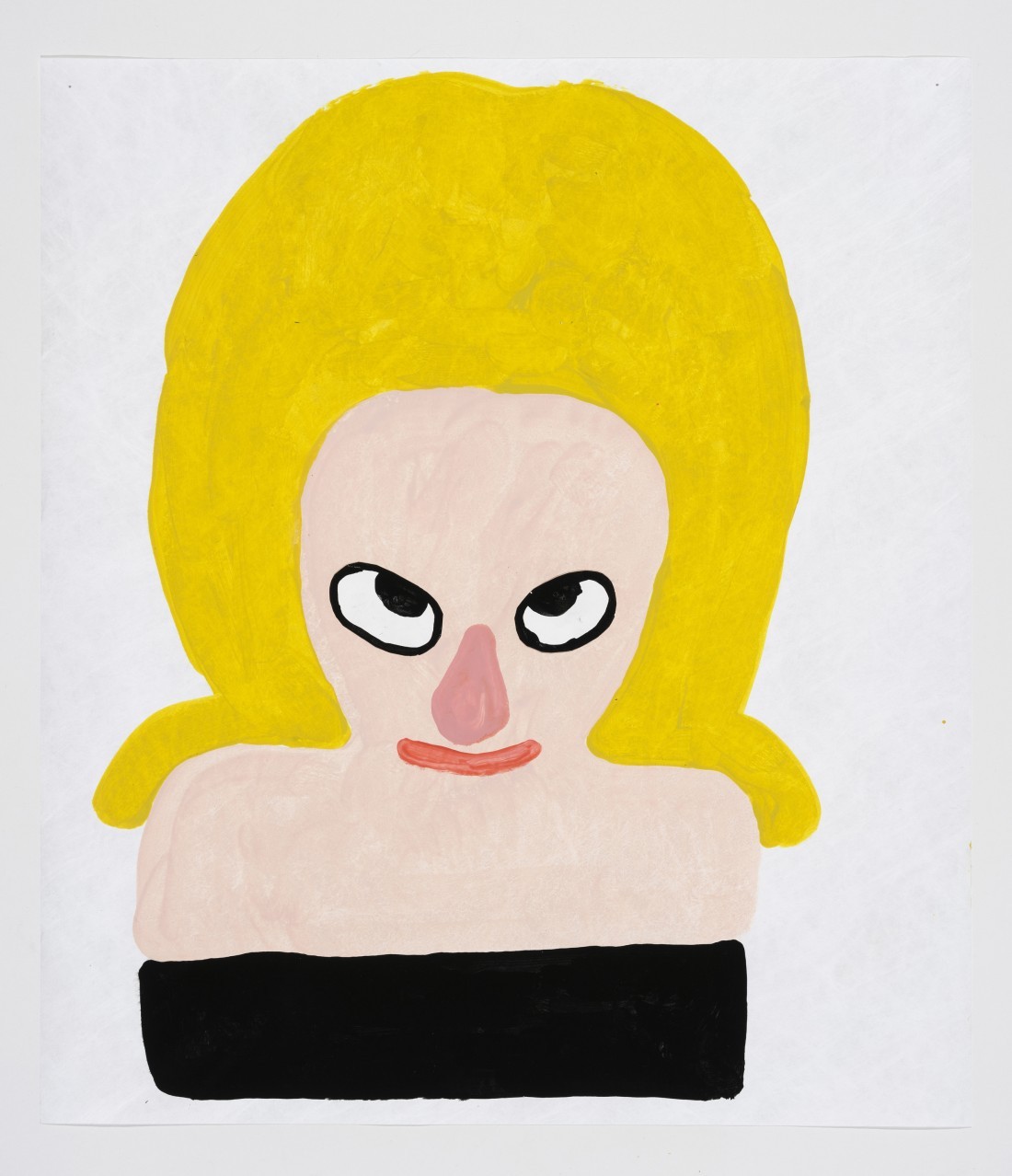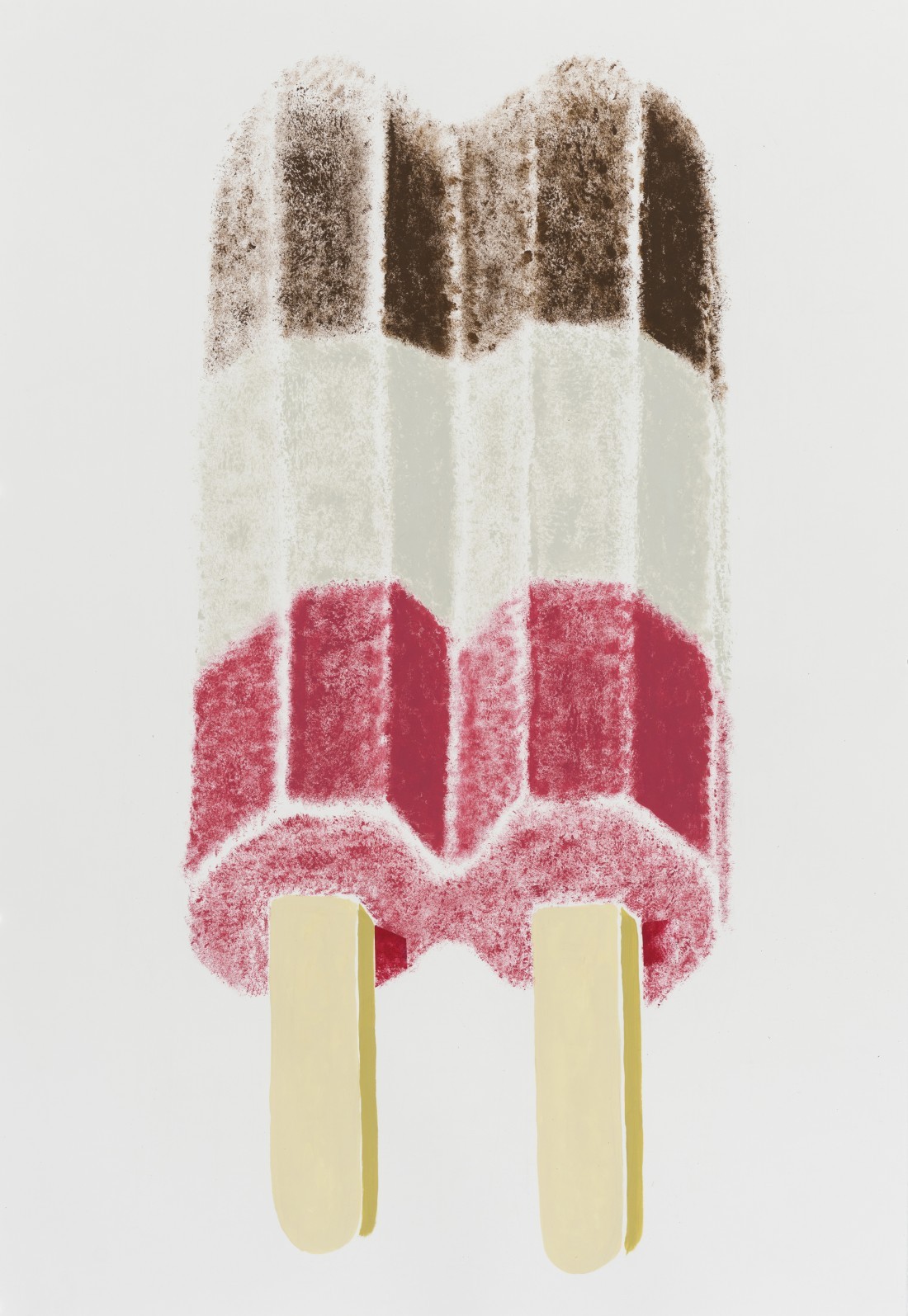Adrian Norvid
Adrian Norvid’s show “Soft Serve” at VivianeArt is a cheery jumble of an exhibition, consisting of two major components. Most spectacular is a large-format work done with pencil and flashe paint on paper, measuring 9 x 25 feet. Soft Serve Penitentiary depicts a comic, chaotic prison that is being visited by a skeptical Kate Bush. The prison is populated by male prisoners with jokey name tags on their uniforms (“sugar free,” “2 much fun” and “easily led”). The guards are anthropomorphized animals, with a jolly, beer-swilling elephant for the warden. Cutaway walls show us multi-level scenes of prisoners and guards drinking, smoking hash, tunnelling, knitting and watching films (advertised on the wall is an upcoming screening of Harry Potter). The cells are adorned with posters of Curtis Mayfield and Stevie Wonder, and interior and exterior walls feature wry slogans and graffiti (“I gotta lotta Beatrix Potter,” “They come to be incarcerated but they stay for the Lasagne”). Everywhere you look in the massive work is another comic vignette. The style is evocative of 1960s counterculture comics by R Crumb and others, as well as the adolescent humour of Mad Magazine. Kate Bush is the sole female figure in the scene (presuming the animal guards are male) and, absent the barbed wire, most of what is depicted would not be out of place in an all-male college dorm, right down to the porn magazines. Similarly satiric takes on contemporary masculinity have featured regularly in Norvid’s work.

Adrian Norvid, Blond, 2021, flashe on Tyvek, 16 × 14 inches. Photo: Kelly Hofer. Images courtesy VivianeArt Gallery, Calgary.

Adrian Norvid, Popsicle, 2022, flashe on paper, 44 × 30 inches. Photo: Kelly Hofer. Courtesy VivianeArt Gallery.
The rest of the exhibition consists of several large groupings of simple, colourful drawings and paintings, often done with a thicker line on vinyl or paper. On the floor are three paper sculptures of shopping bags with slogans—“snooty street,” “snatch this up”—that satirize consumerism parallel to elements of the large-format drawing where Kate Bush has at her feet a crate of 10 dozen pairs of “Withering Tights.” Many of the paintings depict simple, iconic objects floating on a blank background: a toothbrush, a stove, cars, playing cards, a popsicle, a mug, a calculator. Others show generic figures: “Butler with Head,” “Girl on Easy Street,” “Businessman,” “Man and Coin,” “Conductor,” “Man on Yellow Ground,” “Girl in Jail.” Some of these evoke the goofy humour of the penitentiary, such as a cartoon dog who looks uneasily at two red dots hovering above him; a man stretches his tongue towards a lollipop that is stuck to his nose; a butler bears a tray with his own head looking back at him in surprise.

Adrian Norvid, Soft Serve Penitentiary, 2017, flashe on paper, 9 × 25 feet.
A couple of drawings gesture toward more complex situations or emotions. Girl on Easy Street depicts what appears to be a very sad, working- class prostitute standing next to a sign reading “Easy Street.” The joke sits uneasily with the predicament in which the woman finds herself. In another, Girl in Two, a naked woman has been bisected, like the assistant in a magic show, and she looks in dismay or frustration at her lower half. The rendering of her severed torso is a childish imagining of what we look like inside: a white circle representing a cross-section of the spine, surrounded by red meat packed into skin. Although it is a simple, cartoonish rendering, it does include dots for nipples on the breasts and pubic hair on the lower half. The drawing thus links up with the adolescent male sexuality portrayed elsewhere and its often confused aggression: “What the hell is a woman anyway?” Or, to use the language of the drawings, “What is a girl?”
One smaller grouping of three drawings summons up some of the anxieties about female sexuality in the exhibition: in one, a boxer holds two big red gloves in front of his face. In the next, a wide-eyed baker with red cheeks holds up a loaf of bread divided into two plump mounds. In the final one, titled Blond, a ‘glamorous’ woman with a giant bouffant stares aggressively out of the picture (in the context, she could be the immortal Barbara Windsor of the lowbrow British Carry On films, whose figure launched a thousand bra jokes). The joke of this series is perhaps that the blonde is the sole figure of the three who does not have breasts or breast-shaped objects in front of her. Both the boxer and the baker appear startled by what they are holding, as if the femininity of “the blonde” has inadvertently been transferred to them through her confrontational stare.
Soft Serve Penitentiary evokes the overstuffed comic illustrations meant for happy distraction and, perhaps more distantly, the action-packed Renaissance paintings of Pieter Bruegel the Elder that catalogue human foibles, with antic figures depicting “Netherlandish Proverbs” or “The Fight Between Carnival and Lent.” The wall groupings summon up a different Renaissance precursor, the cabinet of curiosity, which presented a jumble of marvels, oddities and semi-precious objects. The shopping bags, however, which lightly satirize consumption, suggest a precursor closer in time, the 19th-century museums of attraction mounted by hucksters like PT Barnum, whose American Museum featured marvels such as a mermaid, taxidermized animals, wax figures of Christ and his disciples and a trained seal named Ned. (One of Norvid’s paintings, of a large pill, evokes Damien Hirst, surely the most Barnum-esque artist alive.) Closer in time still, we might think of the ultra-hip London phenomenon of the Museum of Everything, which updated Barnum’s carnival of curiosities for the art world: sprawling, eclectic shows of outsider art curated by celebrity artists like Ed Ruscha, Thelma Golden and Annette Messager. Fittingly, they also sold quite a bit of merch; Barnum would have been impressed. One could detect similar contradictions in Norvid’s show. If, as certain elements of the exhibition suggest, “Soft Serve” is satirizing masculinity and consumerism, it is a very gentle satire, undertaken with sympathy and a certain amount of knowing complicity: the paintings are, after all, for sale. ❚
“Soft Serve” was exhibited at VivianeArt, Calgary, from June 18, 2022, to July 31, 2022.
Jim Ellis is a professor of English and director of the Calgary Institute for the Humanities at the University of Calgary.

